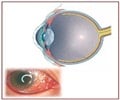Tarantula owners have been asked to keep their face away from their eight-legged pal, and not to forget to wear eye protection.
Tarantula owners have been asked to keep their face away from their eight-legged pal, and not to forget to wear eye protection.
The warning comes after a 29-year-old man went to hospital in February 2009 with a three-week history of a red, watery and light-sensitive eye that did not clear up with antibiotics.Once examined under high magnification lenses, hair-like projections were spotted at varying depths within the cornea.
When these details were discussed with the patient, he immediately recalled an incident that had preceded the onset of his symptoms. 3 weeks earlier, he had been cleaning the glass tank of his pet, a Chilean Rose tarantula.
While his attention was focused on a stubborn stain, he sensed movement in the terrarium. He turned his head and found that the tarantula, which was in close proximity, had released "a mist of hairs" which hit his eyes and face.
The hairs were too small to be removed even with mircoforceps, and the man had to be treated with topical steroids; these largely cleared his symptoms and as of August 2009, he complained of only mild discomfort and intermittent floaters (secondary to the inflammation caused by the hairs).
"The Chilean Rose tarantula has urticating hairs over the posterior aspect of its body. As a defence mechanism against potential predators, the tarantula will rub its hind legs against its abdomen to dislodge these hairs into the air. Multiple barbs allow the hairs to migrate through ocular tissue as well as other surfaces. The inflammatory reaction observed is termed ophthalmia nodosa; a broad diagnosis covering the response of the eye to insect or vegetable material," Dr. Zia Carrim of St. James's University Hospital in Leeds, UK, and his colleagues said.
Advertisement
The report has been published in this week's edition of The Lancet.
Advertisement
RAS












